Performances of the algorithm
Limitations of the algorithm
The algorithm is very efficient in most cases, particularly if the volumes have a rather regular shape and the changes of shape are carried out in a soft manner. Nevertheless, it reaches its limits when the user is trying to create conductors starting from:
- volumes with very acute angles, i.e., with sharp changes of direction
- geometries having strong tangential effects.
These two cases of figure are presented in detail in the modules below with some advice on how to avoid problems and take advantage of the algorithm performances.
Volumes with acute angles
The volume referred to in the left image below has two changes of direction. As the first angle is too acute, the Geometric Tubes (colored in red in the right figure) created to approximate the shape of the volume are to a large extent at the outside of the volume.

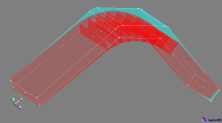
In order to fully exploit the algorithm, the user is invited to cut the volume into two parts in the zone close to the first angle
To this aim, within the context of import of the CAD files, the user can lean on a cut plane. On the other hand, if he works in the standard graphic zone of Flux PEEC, he must define two supplementary lines A and B in the left image below, in order to create the intermediate face, marked in dark turquoise in the image below.
By launching the algorithm in two stages, one for each of the two volumes thus obtained, the created Geometric Tubes in red in the right figure, approximates the initial shape of the volume much better.
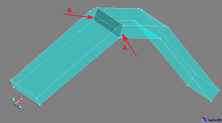
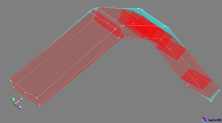
Geometries with strong tangential effects
The geometries representing the cables or the wire bondings can have faces with strong tangential effects, which mean faces where the angle formed by two consecutive sides is very small and the length of these sides is very high. An example is reported in the image below, where the two lines in black represent an angle with a strong tangential effect for the face in red.
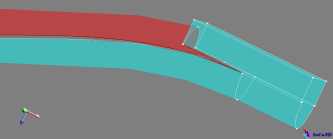
The solution to avoid this effect consists in cutting the initial object into several volumes, thus reducing the surface of the face impacted by the strong tangential effect. The user is invited to perform this operation in the context of the CAD import, in order to lean on a cut plane.
The obtained result is shown in the figure below, where the two faces in red and in green have resulted from the cutting of the initial face. The intermediate face, indicated by the arrow, permits the creation of two distinct volumes:
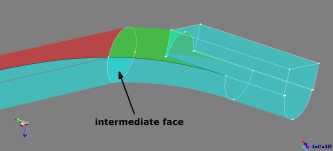
By launching the algorithm in two stages, one for each of the two volumes thus obtained, the Geometric Tubes marked in black in the image below are created to approximate the wire bonding.
